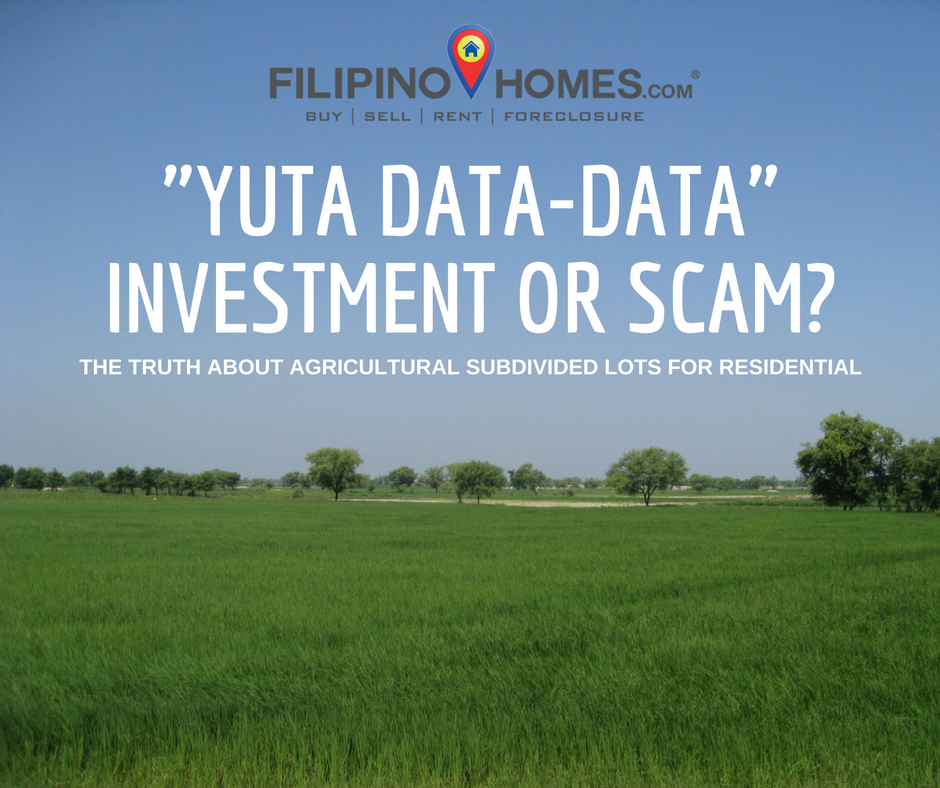 “Yuta Data-data”, Cheap Lots for sale, An agricultural lot sold in small cuts of land for residential purpose, Is it a good investment or a SCAM?
“Yuta Data-data”, Cheap Lots for sale, An agricultural lot sold in small cuts of land for residential purpose, Is it a good investment or a SCAM?
I posted this status few months ago, to see if how many people would agree with me or not. And one of the affirming comments is of course from the Professional Regulation Commission (PRC) Director Dr. Eduardo Ong.
We have been seeing a lot of postings lately about agricultural lots converted to residential lots and being sold in smaller cuts of land in a very inviting price. Some sell it at 35,000 pesos per 200 sqm., some sell it at 150,000 pesos for 0.5 hectares of land. If you see it, the prices are very affordable, how much more if you can pay it in equal installments without interest. Then months and years after you start to build your house, you fenced it and when you’re ready to apply for utilities like water and electricity, you meet trouble. You can’t apply for the following because they will ask you documents you don’t have in the first place. So the series of issues begins.
But would you rather go through with this than have a hassle free investment?
Here are the things you need to check before buying a subdivided piece of land or the so called YUTA-DATA-DATA (Lot for Installment) in the Philippines;
1. Check the LAND TITLE. The land title contains the total land area of the land you are trying to purchase. If it is subdivided into small cuts of land for residential use, the seller should also have the map of the subdivided lots and a copy of land titles for each small cut of land. And make sure that the lot is not included in the non-negotiable for conversion or reclassification under AO 20 (1992);
2. The subdivided lot should have the certificate of reclassification from agricultural land to residential land from LGU. You need to check for this inorder to make sure that you will be able to install utilities and apply for them from the providers of the city/municipality.
Lots are being zoned and classified according to use. Some zones have building restrictions and you are not allowed to install utilities for residential use. Failure to check on that will lead you getting a wrong investment and waste of money. Not all lots you see available are good for residential use.
3. You need to check on subdivision plans. Which includes plans for the drainage systems, access roads and road right of way.
4. Always look for HLURB License to SELL to make sure you have a legit investment. Always guard your investments. You are spending your hard earned money in the first place.
Please keep in mind that there are developers that sells, lot only projects. And some have installment mode of payment. As long as you have all documents present most specially the HLURB License to SELL Number, your investment is pretty much in good shape.
For lot investments or purchase of land outside subdivision projects always do due diligence. Always check the title and get a certified true copy of it from the Registry of Deeds Office, updated TAX Declaration and all the maps and certificates. If they can’t present to you a HLURB LTS, at least they can provide a copy of the certificate of approval for reclassification of the land from agricultural to residential.
—————–
For Guidance please refer to MEMORANDUM CIRCULAR NO. 54
SECTION 1. Scope and Limitations. –
(a) Cities and municipalities with comprehensive land use plans reviewed and approved in accordance with EO 72 (1993), may authorize the reclassification of agricultural lands into non-agricultural uses and provide for the manner of their utilization or disposition, subject to the limitations and other conditions prescribed in this Order.
(b) Agricultural lands may be reclassified in the following cases:
(1) when the land ceases to be economically feasible and sound for agricultural purposes as determined by the Department of Agriculture (DA), in accordance with the standards and guidelines prescribed for the purpose; or
(2) where the land shall have substantially greater economic value for residential, commercial, or industrial purposes as determined by the sanggunian concerned, the city/municipality concerned should notify the DA, HLRB, DTI, DOT and other concerned agencies on the proposed reclassification of agricultural lands furnishing them copies of the report of the local development council including the draft ordinance on the matter for their comments, proposals and recommendations within seven (7) days upon receipt.
(c) However, such reclassification shall be limited to a maximum of the percentage of the total agricultural land of a city or municipality at the time of the passage of the ordinance as follows:
(1) For highly urbanized and independent component cities, fifteen percent (15%);
(2) For component cities and first to third class municipalities, ten percent (10%); and
(3) For fourth to sixth class municipalities, five percent (5%).
(d) In addition, the following types of agricultural lands shall not be covered by the said reclassification :
(1) Agricultural lands distributed to agrarian reform beneficiaries subject to Section 65 of RA 6557;
(2) Agricultural lands already issued a notice of coverage or voluntarily offered for coverage under CARP.
(3) Agricultural lands identified under AO 20, s. of 1992, as nonnegotiable for conversion as follows:
(i) All irrigated lands where water is available to support rice and other crop production;
(ii) All irrigated lands where water is not available for rice and other crop production but within areas programmed for irrigation facility rehabilitation by DA and National Irrigation Administration (NIA); and
(iii) All irrigable lands already covered by irrigation projects with form funding commitments at the time of the application for land conversion or reclassification.
(e) The President may, when public interest so requires and upon recommendation of the National Economic Development Authority (NEDA), authorize a city or municipality to reclassify lands in excess of the limits set in paragraph (d) hereof. For this purpose, NEDA is hereby directed to issue the implementing guidelines governing the authority of cities and municipalities to reclassify lands in excess of the limits prescribed herein.
SECTION 2. Requirements and Procedures for Reclassification. –
(a) The city or municipal development council (CDC/MDC) shall recommend to the sangguniang panlungsod or sangguniang bayan, as the case may be, the reclassification of agricultural lands within its jurisdiction based on the requirements of local development.
(b) Prior to the enactment of an ordinance reclassifying agricultural lands as provided under Sec. 1 hereof, the sanggunian concerned must first secure the following certificates form the concerned national government agencies (NGAs):
(1) A certification from DA indicating –
(i) the total area of existing agricultural lands in the LGU concerned;
(ii) that which lands are not classified as non-negotiable for conversion or reclassification under AO 20 (1992); and
(iii) that the land ceases to be economically feasible and sound for agricultural purposes in the case of Sec. 1 (b-1).
(2) A certification from DAR indicating that such lands are not distributed or not covered by a notice of coverage or not voluntarily offered for coverage under CARP.
(c) The HLRB shall serve as the coordinating agency for the issuance of the certificates as required under the preceding paragraph. All applications for reclassification shall, therefore, be submitted by the concerned LGUs to the HLRB, upon receipt of such application, the HLRB shall conduct initial review to determine if:
(1) the city or municipality concerned has an existing comprehensive land use plan reviewed and approved in accordance with EO 72 (1993); and
(2) the proposed reclassification complies with the limitations prescribed in SECTION 1 (d) hereof. Upon determination that the above conditions have been satisfied, the HLRB shall then consult with the concerned agencies on the required certifications. The HLRB shall inform the concerned agencies, city or municipality of the result of their review and consultation. If the land being reclassified is in excess of the limit, the application shall be submitted to NEDA. Failure of the HLRB and the NGAs to act on a proper and complete application within three months from receipt of the same shall be deemed as approved thereof.
(d) Reclassification of agricultural lands may be authorized through an ordinance enacted by the sangguniang panlungsod or sangguniang bayan, as the case may be, after conducting public hearings for the purpose. Such ordinance shall be enacted and approved in accordance with Articles 107 and 108 of the IRR of the LGC.
(e) Provisions of Sec. 1 (b-2) hereof to the contrary notwithstanding, the sanggunian concerned shall seek the advice of DA prior to the enactment of an ordinance reclassifying agricultural lands. If the DA has failed to act on such request within thirty (30) days from receipt thereof, the same shall be deemed to have been complied with. Should the land subject to reclassification is found to be still economically feasible for agriculture, the DA shall recommend to the LGU concerned alternative areas for development purposes.
(f) Upon issuance of the certifications enumerated in Section 2 (b) hereof, the sanggunian concerned may now enact an ordinance authorizing the reclassification of agricultural lands and providing for the manner of their utilization or disposition. Such ordinance shall likewise update the comprehensive land use plans of the LGU concerned.
SECTION 3. Review of ordinances reclassifying agricultural lands. – All ordinances authorizing the reclassification of agricultural lands shall be subject to the review and approval by the province in the case of a component city or municipality, or by HLRB in the case of a highly urbanizable or independent component city in accordance with EO 72 (1993).
SECTION 4. Use of the comprehensive land use plans and ordinances as primary reference documents in land use conversions. – Pursuant to RA 6657 and EO 129-A, actions on applications for land use conversions on individual landholdings shall remain as the responsibility of DAR, which shall utilize as its primary reference documents the comprehensive land use plans and accompanying ordinance passed upon and approved by the LGUs concerned, together with the National Land Use Policy.
SECTION 5. Monitoring and evaluation of land reclassification by LGUs concerned. – Within six (6) months from the issuance of this Order, the HLRB shall design, in coordination with DA, DAR, Department of the Interior and Local Government (DILG), NEDA, League of Provinces, League of Cities and League of Municipalities, and install a monitoring and evaluation system for the reclassification of agricultural lands authorized by cities and municipalities. The HLRB shall submit semestral reports to the Office of the President. A copy thereof shall be furnished the DA, DAR, DILG, NEDA, League of Provinces, League of Cities, and League of Municipalities.
SECTION 6. Transitory provision. – Provisions of Secs. 1 (a) and 2 (b) to the contrary notwithstanding, cities and municipalities with land use plans approved not earlier than 01 January 1989, may authorize the reclassification of agricultural lands in accordance with the limitations and conditions prescribed in this Order. However, when the LGU has not reclassified up to the said limitations, further reclassification may be exercised only within five years from approval of the plan. Thereafter, all reclassifications shall require approval from the President pursuant to Sec. 1(e) of this Circular.
SECTION 7. Effectivity. – This Circular shall take effect immediately
——————-
Sources:
To know more about converting agricultural lands to residential lots click here: Reclassification of Agricultural Land.





